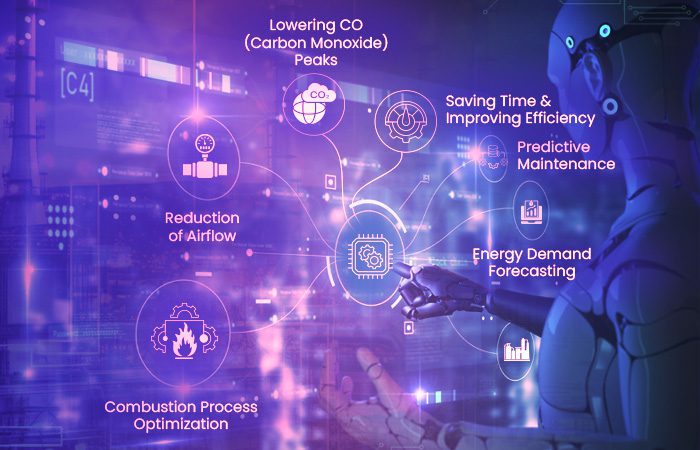
6 Game-changing Benefits of Artificial Intelligence in Power Plants
The energy sector is gradually transitioning from traditional operations to more sustainable business formats as we become increasingly environmentally conscious, backed by the introduction of cutting-edge technologies. In this regard, next-gen innovations can help to enhance procedures, boost productivity, and enable better decision-making, thereby making it an increasingly potent factor for optimum business success.
Moreover, the pressure to optimize power plants in now more severe than ever and thus, it is crucial for all resources and equipment to work at their optimum capacity to avoid costly downtimes, efficiency losses and expensive repairs. One technology that is gaining wider recognition in the energy sector is artificial intelligence (AI). The implementation of AI in power plants brings significant advantages, improving efficiency, safety, and sustainability. Here are some 6 reasons highlighting the importance of AI in power plants:
- Combustion Process Optimization
When Artificial Intelligence is configured correctly, it performs as well as a human power plant operator, if not better. The AI can make decisions about how to optimize operations faster by considering more variables and assessing each problem set objectively. There have been instances where AI integration in combustion processes boosts the effectiveness of waste incineration facilities, with waste throughput increasing by 10%. Burning more waste increases the plant’s profit because it receives a gate fee for each ton of waste burned. Additionally, the concerned facilities can produce extra energy to be sold on the market.
- Reduction of Airflow
It is crucial to reduce the amount of air passing through the system in waste-to-energy plants. At the end of the process, the amount of exhaust gas or flue gas released will be directly influenced by the air, with more air resulting in more flue gas. Less flue gas will result from decreasing the amount of air used in combustion, which will lower maintenance and corrosion costs. The advantage of reducing air with the implementation of AI is not readily apparent because it is more challenging to calculate maintenance costs than the profit from increasing waste throughput. The system’s O2 level does, however, decrease by at least 30%, bringing it into the desired range. This enhancement clearly has positive effects on how the plant runs.
- Lowering CO (Carbon Mono-oxide) Peaks
By identifying developments before they even materialize, AI can anticipate carbon mono-oxide (CO) peaks pre-emptively. It comprehends the entire system and data patterns that eventually cause CO levels to rise. Before the increase occurs, the AI intervenes to prevent it, lowering the overall level of emission. Traditional automation clearly has an advantage because it can anticipate these developments and take action to prevent them before they happen.
- Saving Time & Improving Efficiency
Most importantly, the AI saves the human operator time by performing tasks that they would otherwise have to perform themselves. Every operational person typically has to manage and optimize several lines at once. The AI frees the human from having to constantly adjust those lines so that they can concentrate on other, more crucial tasks. The AI can run simultaneously on autopilot in smaller plants where operators must travel during their shifts to inspect machinery while also overseeing operations, giving the operator time to perform tasks like fine-tuning the combustion engine.
- Predictive Maintenance
Power plants involve numerous complex machinery and equipment that require proper maintenance to ensure uninterrupted operations. AI-driven predictive maintenance systems employ advanced algorithms and machine learning techniques to monitor the performance of critical components and identify potential faults or failures. By pinpointing maintenance requirements before they cause major issues, AI-based systems reduce downtime, minimize maintenance costs, and enhance plant reliability.
- Energy Demand Forecasting
Accurate energy demand forecasting is crucial for power plant operators to optimize energy generation and distribution. AI can utilize historical data, weather patterns, economic indicators, and other variables to predict demand patterns with high precision. This allows power plants to dynamically adjust their output, reduce unnecessary energy generation, and avoid overloading the grid. Consequently, AI aids in optimizing power generation, reducing costs, and ensuring stability in the electrical grid.
Apart from these, AI also plays a role in grid optimization and reducing overall environmental impact. The integration of renewable energy sources, such as wind and solar, into the power grid poses unique challenges due to their intermittent nature. AI algorithms can optimize the coordination and balancing of various energy sources within the grid, ensuring efficient utilization and minimizing disruptions. AI can also enable dynamic price settings, demand-side management, and load forecasting, leading to better grid stability and resource allocation.
Similarly, AI can greatly contribute to reducing the environmental footprint of power plants. By utilizing AI-based analytics, power plants can optimize energy usage, reduce emissions, and identify opportunities for energy conservation. AI can also aid in integrating renewable energy sources seamlessly, accelerating the transition to clean, sustainable energy solutions.
Thus, with AI’s ability to process massive amounts of data and make intelligent decisions, power plants can operate more effectively, cost-efficiently, and sustainably in the face of evolving energy demands and global environmental concerns.

